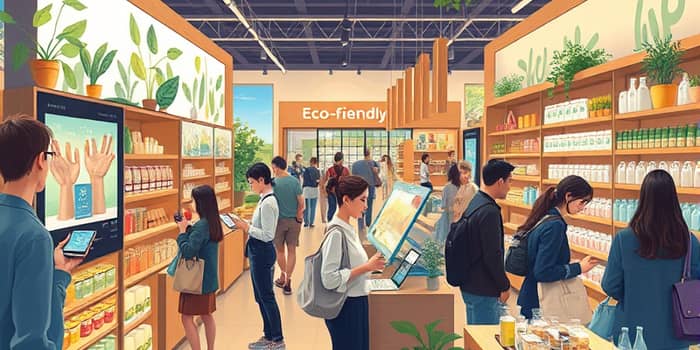As we approach 2025, the retail landscape stands at a crossroads, shaped by economic headwinds, technological breakthroughs, and evolving consumer values. The era of unfettered growth is giving way to moderation in discretionary categories as shoppers prioritize essentials and weigh every purchase. Yet, within these constraints lies opportunity—innovative brands and agile retailers can thrive by understanding the new rules of engagement.
Shifting Economic Foundations and Consumer Spending
The macroeconomic backdrop is redefining the contours of retail. US consumer spending growth is projected to slow to 3.7% in 2025, down from 5.7% in 2024. Retail sales are expected to reach between $5.42 and $5.48 trillion, growing 2.7–3.7% year over year. While low unemployment and wage gains continue to support household incomes, consumers are cautious. Inflation, rising tariffs, and high borrowing costs have prompted many to tighten their belts.
Shoppers are increasingly focusing on groceries and household essentials, trimming budgets for apparel, home goods, and luxury items. This shift reflects broader sentiment: uncertainty looms large even as job markets remain strong. Retailers must navigate this delicate balance—the steady drumbeat of consumer demand tempered by prudent spending habits.
Redefining Value: Consumer Priorities Evolve
Value no longer equates to lowest price—it encompasses quality, convenience, and meaningful experiences. Recent data reveals that 79% of global consumers are trading down, seeking deals without sacrificing needs. Meanwhile, 49% of US shoppers plan to delay purchases over the next three months, underscoring the importance of timely promotions.
- Cross-category trade-downs allow shoppers to splurge selectively.
- Experiential spending—fitness classes, entertainment, value dining—is rebounding strongly.
- High-income households continue to drive growth, even as mid-income segments remain cautious.
Understanding these nuanced behaviors enables retailers to tailor offerings—bundling essentials with occasional treats, for example—and to communicate the full spectrum of value beyond price alone.
Technology and Retail Innovation
Technology remains a powerful catalyst for change. From AI-driven personalization to seamless e-commerce integration, retailers are embracing digital tools to meet evolving expectations. Customers today demand faster checkouts, tailored recommendations, and a unified experience across channels.
Leaders in the space deploy cutting-edge AI-driven personalization techniques to craft targeted promotions and optimize inventory. Direct-to-consumer models, powered by predictive logistics and smart analytics, challenge traditional retail giants. Meanwhile, grocery chains and big-box stores are launching private labels with D2C agility, blending scale with speed.
The rise of digital payments, subscription services, and contactless shopping has fueled non-store sales growth of 7–9% year over year, projecting at $1.6 trillion in 2025. Retailers who harness data effectively will not only streamline operations but also create seamless omnichannel customer experiences that drive loyalty.
Sustainability, Ethics, and Generational Influence
The call for sustainability has never been louder. Globally, 58% of consumers are willing to pay a premium for eco-friendly products; this rises to 60% among Millennials and 58% for Gen Z. Transparent sourcing, ethical labor practices, and reduced environmental impact are no longer optional—they are core expectations.
Younger generations are vocal champions of these causes and wield growing purchasing power—Gen Z is set to surpass Baby Boomers by 2030, with an estimated $68 trillion wealth transfer. While secondhand shopping has dipped, the demand for authentic sustainability initiatives remains robust.
Brands must integrate authentic sustainability as a core pillar of their business, moving beyond marketing campaigns to embed ethical practices in every step: from product design to end-of-life recycling and community engagement.
Brick-and-Mortar Resurgence and Real Estate Dynamics
Despite the digital surge, physical stores are far from obsolete. Foot traffic in experience-driven categories—fitness studios, entertainment venues, and discount dining—continues to rise. Prime retail locations remain in high demand, although weaker markets face growing vacancies.
Apparel stores see steady visits, buoyed by off-price retailers, while big-ticket and discretionary segments wrestle with softer traffic. Grocery and superstore visits show mixed performance across regions, highlighting the need for localized strategies and store formats that resonate with community needs.
Brand Strategies and the Retail Arms Race
In this competitive arena, brands must be nimble. Discount chains like Dollar General and Costco excel on affordability, while premium D2C names such as Nike and Lululemon leverage exclusivity and immersive experiences to retain loyalists. Promotional calendars are critical—47% of US apparel consumers wait for sales events to shop.
- Embrace a multichannel approach: blend online agility with in-store engagement.
- Invest in data-driven decision-making to align inventory with real-time demand.
- Position ethical and sustainable practices at the heart of your brand promise.
Successfully balancing these dimensions can transform challenges into growth opportunities, forging deeper connections with today's discerning consumers.
Forecasting the Future: Caution Flags and Opportunities
Looking ahead, growth is expected to remain steady but unspectacular. Consumer sentiment could tighten further if inflation surges or interest rates climb. Notably, volume growth continues to lag dollar growth—signaling higher prices, not necessarily greater demand.
Retailers must perform a delicate balance between cost, innovation, and consumer appetite, investing in technology and sustainability while safeguarding margins. Those who pivot swiftly, listening to their customers and anticipating shifts, will emerge as winners in the next phase of the retail revolution.
In conclusion, the retail revolution is not a single event but an ongoing transformation. Retailers that comprehend shifting consumer spending patterns, invest in technology, champion sustainability, and craft memorable in-store experiences will write the next chapter of success. The blueprint is clear: adapt, innovate, and remain relentlessly customer-centric. Those who do so will thrive in a rapidly changing retail landscape, forging enduring loyalty and driving growth well into the future.
References
- https://www.crispidea.com/us-retail-trends-2025-ai-d2c-grocery-shifts/
- https://www.market-xcel.com/us/blogs/top-7-us-consumer-trends-retail-challenges
- https://www.gwi.com/blog/consumer-spending-trends
- https://www.cogentinfo.com/resources/retail-revolution-top-10-trends-shaping-the-industry-in-2025
- https://myhfa.org/2025-retail-outlook-steady-growth-amid-shifting-consumer-sentiment/
- https://www.mckinsey.com/industries/consumer-packaged-goods/our-insights/state-of-consumer
- https://www.credaily.com/briefs/retail-resilience-shapes-2025-consumer-trends/
- https://traxretail.com/blog/analyzing-summer-2025-buying-habit-shifts/










